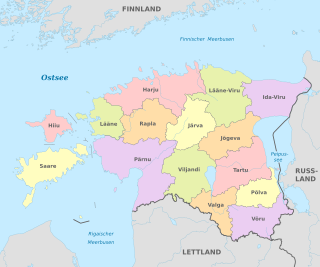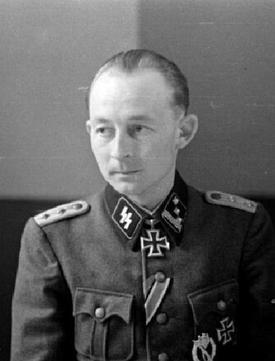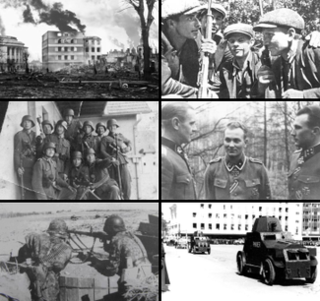
Counties are the state administrative subdivisions of Estonia. Estonian territory is composed of 15 counties, including 13 on the mainland and 2 on islands. County governments were abolished at the end of 2017, with their duties split between state authorities and local governments, and nowadays counties have no noteworthy independent competences. Counties are composed of municipalities of two types: urban municipalities and rural municipalities, which are by law required to cooperate in development of their county.

Valga is a town in southern Estonia and the capital of Valga County and Valga Parish. Until their separation in 1920, Valga and the town of Valka in northern Latvia were one town. They are now twin-towns. The area of Valga is 16.5 square kilometres and that of Valka is 14.2 km2 (5.5 sq mi). Their populations are respectively 12,261 and 6,164. On 21 December 2007 all border-crossing points were removed and roads and fences opened between the two countries with both countries joining the Schengen Agreement.

The Estonian War of Independence, also known as the Estonian Liberation War, was a defensive campaign of the Estonian Army and its allies, most notably the United Kingdom, against the Soviet Russian westward offensive of 1918–1919 and the 1919 aggression of the pro–German Baltische Landeswehr. The campaign was the struggle of the newly established democratic nation of Estonia for independence in the aftermath of World War I. It resulted in a victory for Estonia and was concluded in the 1920 Treaty of Tartu.

The 20th Waffen Grenadier Division of the SS was a foreign infantry division of the Waffen-SS that served alongside but was never formally part of the Wehrmacht during World War II. According to some sources, the division was under Reichsführer-SS Heinrich Himmler's overall command but was not an integral part of the Schutzstaffel (SS). It was officially activated on 24 January 1944, and many of its soldiers had been members of the Estonian Legion and/or the 3rd Estonian SS Volunteer Brigade, which had been fighting as part of German forces since August 1942 and October 1943 respectively. Both of the preceding formations drew their personnel from German-occupied Estonia. Shortly after its official activation, widespread conscription within Estonia was announced by the German occupying authorities. The division was formed in Estonia around a cadre comprising the 3rd Estonian SS Volunteer Brigade, and was initially known as the 20th Estonian SS Volunteer Division.
The flags of the 15 counties of Estonia are all white and green, with the coat of arms of the respective county on the white part. This design was first established in 1938. The list also includes the historical flag of Petseri County, which in 1944 was occupied by Soviet forces and became Pechorsky District in Pskov Oblast, present-day Russia. The district was claimed by Estonia after the re-establishing of independence in 1991, but the claim was dropped in 1995. The county governments along with county governors were abolished with the 2017 administrative-territorial reform, and their tasks were transferred to ministries, so it is unusual to see these flags in use nowadays.

In the course of Operation Barbarossa, Nazi Germany invaded Estonia in July–December 1941, and occupied the country until 1944. Estonia had gained independence in 1918 from the then-warring German and Russian Empires. However, in the wake of the August 1939 Nazi-Soviet Pact, the Stalinist Soviet Union had invaded and occupied Estonia in June 1940, and the country was formally annexed into the USSR in August 1940.

The history of Jews in Estonia starts with reports of the presence of individual Jews in what is now Estonia from as early as the 14th century.

Julius Kuperjanov VR I/2, VR II/2 and VR II/3 was an Estonian military officer who was well-known in Estonia for being one of the Liberators of Tartu during the War of Independence and commander of the Tartumaa Partisan Battalion.
The coats of arms of the 15 counties of Estonia are presented below.

Paul Maitla was an Estonian commander in the German Waffen-SS during World War II. He is one of the four Estonians who received the Knight's Cross of the Iron Cross of Nazi Germany. He received his award for leading the recapture of the central hill of the Sinimäed during the Battle of Tannenberg Line, effectively breaking the Soviet offensive in that sector.

The Holocaust in Estonia refers to Nazi crimes during the occupation of Estonia by Nazi Germany.

Estonia declared neutrality at the outbreak of World War II (1939–1945), but the country was repeatedly contested, invaded and occupied, first by the Stalinist Soviet Union in 1940, then by Nazi Germany in 1941, and ultimately reinvaded and reoccupied in 1944 by the Soviet Union.

The Kuperjanov Infantry Battalion is a battalion of the Estonian Land Forces. It is a part of the 2nd Infantry Brigade. Battalion headquarters is at Taara Army Base, Võru.

The Estonian Police was the law enforcement agency of Estonia. It was subordinate to the Ministry of the Interior. In 2010, the organization was superseded by the Police and Border Guard Board.

The Omakaitse was a militia organisation in Estonia. It was founded in 1917 following the Russian Revolution. On the eve of the occupation of Estonia by the German Empire, the Omakaitse units took over major towns in the country allowing the Salvation Committee of the Estonian Provincial Assembly to proclaim the independence of Estonia. After the German Occupation the Omakaitse became outlawed.

The Estonian Border Guard was the national security agency responsible for the border security of Estonia. It was subordinate to the Ministry of the Interior. The Border Guard also assisted with Search and Rescue missions. In 2010, the organization was superseded by the Police and Border Guard Board.

The Tartu offensive operation, also known as the Battle of Tartu and the Battle of Emajõgi was a campaign fought over southeastern Estonia in 1944. It took place on the Eastern Front during World War II between the Soviet 3rd Baltic Front and parts of the German Army Group North.
Estonian Auxiliary Police were Estonian police units that collaborated with the Nazis during World War II.
The 180th Rifle Division was an infantry division of the Soviet Red Army, formed thrice.

The Battle of Tartu was fought between the 13th and 14th of January, 1919 in the Estonian War of Independence between the units of the Estonian 2nd Division and the forces of the Red Latvian Riflemen. The battle was a significant battle in the Estonian War of Independence, allowing Estonian troops to liberate the rest of Southern Estonia from Soviet forces.














